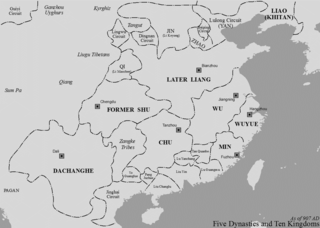
King Ping of Zhou, personal name Ji Yijiu, was the thirteenth king of China's Zhou dynasty and the first of the Eastern Zhou dynasty.

Jin, originally known as Tang (唐), was a major state during the middle part of the Zhou dynasty, based near the centre of what was then China, on the lands attributed to the legendary Xia dynasty: the southern part of modern Shanxi. Although it grew in power during the Spring and Autumn period, its aristocratic structure saw it break apart when the duke lost power to his nobles. In 403 BC, the Zhou court recognized Jin's three successor states: Han, Zhao, and Wei. The Partition of Jin marks the end of the Spring and Autumn period and the beginning of the Warring States period.
Marquis Wu of Jin, personal name Ji Ningzu, was a ruler of the Jin state. He succeeded his father, Ji Xiefu, to the throne. He was in turn succeeded by his son, Marquis Cheng.
Marquis Cheng of Jin, personal name Ji Furen, was a marquis of the Jin state. He succeeded his father, Marquis Wu, and was in turn succeeded by his son, Marquis Li.
Marquis Li of Jin, personal name Ji Fu, was a monarch of the Jin state. He succeeded his father, Marquis Cheng, to the Jin throne.
Marquis Jing of Jin, personal name Ji Yijiu, was a marquis of the Jin state. He was the successor of Marquis Li, his father. He was in turn succeeded by his son, Marquis Xi.
Marquis Xian of Jin, personal name Ji Ji or Ji Su, was a marquis of the Jin state. He was preceded by his father, Marquis Xi, and succeeded by his son, Marquis Mu.
Marquis Mu of Jin, personal name Ji Feiwang, was a monarch of the Jin state. He succeeded his father, Marquis Xian, to the throne of Jin.
Shang Shu of Jin, personal name unknown, was a ruler of the Jin state. He usurped the throne of Jin after his elder brother, Marquis Mu, died in 785 BC. After Shang Shu ascended the throne, Marquis Mu's son, Ji Chou, was forced to leave Jin in fear of his uncle.
Marquis Wen of Jin, personal name Ji Chou, was a marquis of the Jin state. He was also the first ruler of Jin in the Spring and Autumn period.
Marquis Zhao of Jin, personal name Ji Bo, was a ruler of the Jin state.
Marquis Xiao of Jin, personal name Ji Ping, was a monarch of the Jin state.
Marquis Ai of Jin, personal name Ji Guang, was a marquis of the Jin state. He reigned from 718 BC to 709 BC.
Marquis Xiaozi of Jin, given name unknown, was a ruler of the Jin state. He reigned for four years from 708 BC to 705 BC.
Ji Min, commonly known as "Min, Marquis of Jin", was a marquis of the Jin. He was the last Jin monarch from the original line of the ruling Ji clan, before the throne was taken over by the branch from Quwo. He reigned for 27 years.
Duke Wu of Jin, personal name Ji Cheng, also known as Duke Wu of Quwo, was the last ruler of the Quwo (曲沃) state who later became a ruler of the Jin state.

Jin, also known as Hedong (河東) and Former Jin (前晉) in Chinese historiography, was a dynastic state of China and the predecessor of the Later Tang dynasty. Its princely rulers were the ethnic Shatuo warlords Li Keyong and Li Cunxu. Although the Five Dynasties period began only in 907, Li Keyong's territory which centered around modern Shanxi can be referred to as Jin as early as 896, when he was officially created the Prince of Jin by the failing and powerless Tang dynasty court, or even as early as 883, when he was created the jiedushi military governor of Hedong Circuit, which controlled more or less the same territory.
Duke Jing of Jin, personal name Ji Ju or Ji Nou, was monarch of the Jin state from 599 BC to 581 BC. He succeeded his father, Duke Cheng, who died in 600 BC.
Duke Qing of Jin, personal name Ji Quji or Ji Qiji, was the ruler of the Jin state from 525 BC to 512 BC. He succeeded his father, Duke Zhao, who died in 526 BC.
Duke Jing of Jin, personal name Ji Jiao, was from 451 BC to 434 BC the duke of the Jin state.



